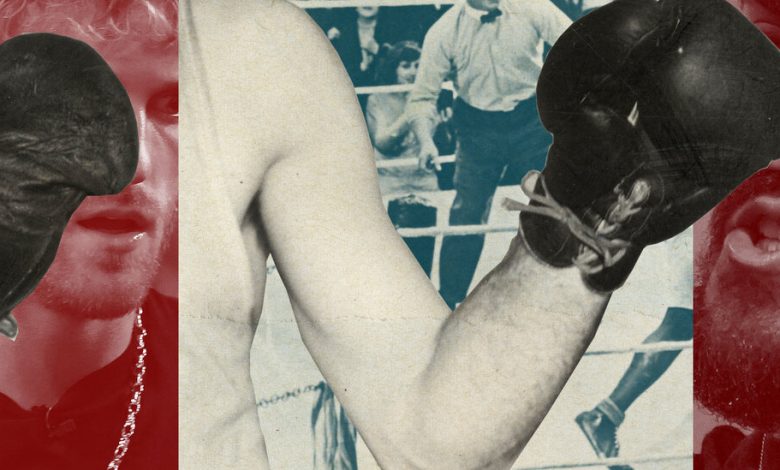Why People Love to Watch Influencers Get Punched In the Face

Early in September, when the social media star Logan Paul and the mixed-martial-arts welterweight Dillon Danis sat down for an interview in advance of their Oct. 14 boxing match, they seemed less like professional athletes and more like high school bullies vying to supplant each other in popularity. It wasn’t just the mini-mullets or the cocky schoolboy grins; it was the second-rate insults and personal attacks that ping-ponged back and forth. “Mr. Mumble-Jumble-Stumble his way through a sentence,” Paul taunted when Danis tripped over his words. Danis repeated, ad nauseam, “You’re a scumbag, bro.” “The hate between these two is real,” DAZN, the streaming service set to air the fight, declared. This was the central narrative promoting the match. In lieu of top talent or actual competitive stakes, things began with Danis and Paul’s celebrity and operatic rivalry: Maybe that would attract hundreds of thousands of viewers and tens of millions of dollars to an otherwise middling boxing match.
It is mostly just the allure of realism that distinguishes the bout from the average World Wrestling Entertainment broadcast. (Paul, in fact, performs for W.W.E. on a part-time basis.) There’s all the cartoonish chest-puffing and narrative-building of pro wrestling, but instead of scripted outcomes and choreographed body slams, fighters like these two are eventually required to square off without staging or intervention. The publicity may be strained and the plots spurious, but in the ring there is no hiding from the reality of a jab, a cross, blood leaking from a swollen eye. Boxing satisfies a basic comparative and competitive instinct: It is this guy versus that guy, with only their gloved fists — not their number of Instagram followers or lucrative brand deals — at their disposal. There’s poetry in how plainly human the whole thing is.
But the poetry of the bout itself doesn’t always sell pay-per-view packages. These days, many of the sport’s most popular fights don’t feature world champions or rising talents. They feature social media influencers and retired-but-still-famous boxers pining for a paycheck. What’s more entertaining: the bantamweight world-title match or a rock-bottom 2021 squabble between the retired N.B.A. player Lamar Odom and the former child star Aaron Carter? An eight-round heavyweight qualifier or watching the family vlogger Austin McBroom knock out the TikTok frat bro Bryce Hall? In 2020, a friendly face-off between two middle-aged legends, Mike Tyson and Roy Jones Jr., drew massive viewership because, well, it was Mike Tyson. Floyd Mayweather Jr. has spent his post-retirement life showing up to novelty exhibitions for eight-figure sums. And who among us wouldn’t consider tuning in to that much-discussed Mark Zuckerberg and Elon Musk cage match?
These fights garner interest because of their characters, not their quality. This is the world of influencer boxing, of internet-famous tough guys and celebrities clinging to relevance, of manufactured beefs and emotional arcs plotted via training videos and podcast appearances. Influencer boxers know something boxing purists don’t: that a fight without a narrative, no matter how poetic its execution, is just a hollow technical exercise.
Boxing promoters have spent decades enticing viewers with the prospect of seeing celebrities in the ring. In 1991, when the former N.F.L. All-Pro Mark Gastineau became a professional fighter — a popular figure suddenly competing in a very new context — his career attracted national interest. (“60 Minutes” later reported that most of his fights were fixed, with opponents paid to take dives.) The appeal of familiar faces in violent battles emerged in fiction, too, as with “Celebrity Deathmatch,” which debuted in 1998 and featured stop-motion animations of celebrities killing each other in the ring. In 2002, Fox ran two episodes of “Celebrity Boxing,” starring the likes of Vanilla Ice and Tonya Harding, before canceling it. (TV Guide would later rank it the sixth-worst show ever.) That same year, Donald Trump’s Atlantic City casino hosted the “Brawl at the Taj Mahal,” a stunt fight between two regulars on Howard Stern’s radio show. Such spectacles may not have the craft of top-tier boxing, but they capitalize on a powerful force: the desperate demeanor of people prepared to do anything to grow or maintain their fame.
Logan Paul and his younger brother Jake Paul seem to understand the power of narrative better than their peers. Jake is a Disney Channel actor turned YouTuber turned rapper; Logan is a YouTuber turned podcaster turned energy-drink salesman. Each began boxing in 2018. Since then, Logan has lost to Mayweather in a widely publicized exhibition match, while Jake has landed among the most recognized names in boxing, cultivating the image of a renegade disrupting the sport. It hardly matters to viewers that the Pauls are top-tier self-promoters but (at best) midtier boxers. What matters is their flair for the dramatic and their internet-bred ability to get people to care about them.
In every other professional sport, major events promise elite performance first, and then search for narratives to enliven them. The record-setting ratings at this year’s U.S. Open tennis final between Coco Gauff and Aryna Sabalenka, for instance, owed something to Gauff’s irresistible ascension and charisma, but they were earned mostly by the otherworldly talent on display. Yet in boxing there is no longer a discernible marriage between talent and narrative. To care about the fight between Paul and Danis — or one between the rapper Blueface and the TikToker Ed Matthews, or the retired N.F.L. star Le’Veon Bell and the YouTuber JMX — is to care almost exclusively about the caricatures these figures present. There are no real athletic stakes, no championship belt to be lifted. The match’s meaning is derived almost solely from its plotting.
Boxing as a mainstream entertainment, the stuff of front pages and towering athletes, had its peak in the 20th century; now, increasingly, it is a niche product, not a mass-market one. As the combat-sports journalist Ariel Helwani said in an episode of Netflix’s “Untold” documentary series spotlighting Jake Paul, “I can’t tell you just how hard it is to get people to be emotionally invested, to get people to care, to get people to buy pay-per-views and tickets.” But there is a robust new audience that follows social-media celebrities and would not mind watching them duke it out. If nothing else, the Pauls know how to curry that attention. Before pivoting to boxing, Logan was perhaps best known for posting a video of a body hanging from a tree in Japan’s “suicide forest,” a stunt that spawned outrage and led YouTube to suspend his ad revenue. Somehow, he emerged from the controversy more famous than before, reinforcing a sinister lesson about content creation: Do whatever it takes to maximize engagement.
Like YouTube and brand ambassadorship, boxing is a good platform for languishing in a state of demi-celebrity, where neither elite talent nor ethics is a prerequisite. It’s no wonder the Pauls fit in. Danis, for his part, is a perfect partner: In the buildup to his fight with Logan, he has posted pornographic video supposedly featuring Paul’s fiancée, the model Nina Agdal, and devoted his social media to shaming her. (She has gotten a restraining order.) Paul, meanwhile, has called Danis’s mother an “actual prostitute.” Here, it seems, are the bullies yapping about their fight in the parking lot and persuading their peers, against their better judgment, to gawk at whoever raises his arms in triumph.
Source photographs for image above: Cliff Hawkins/Getty Images; Christian Petersen/Getty Images; Hulton Archive/Getty Images; UPI/Alamy Stock Photo; PA Images/Alamy Stock Photo.



